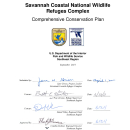What We Do
Wildlife conservation is at the heart of the National Wildlife Refuge System. It drives everything on U.S. Fish and Wildlife Service lands and waters managed within the Refuge System, from the purposes for which a national wildlife refuge national wildlife refuge
A national wildlife refuge is typically a contiguous area of land and water managed by the U.S. Fish and Wildlife Service for the conservation and, where appropriate, restoration of fish, wildlife and plant resources and their habitats for the benefit of present and future generations of Americans.
Learn more about national wildlife refuge is established to the recreational activities offered to the resource management tools used. Using conservation best practices, the Refuge System manages Service lands and waters to help ensure the survival of native wildlife species.
Water Management
Habitat management at Harris Neck NWR is focused on six man-made impoundments utilized by wood storks and a variety of other resident wading birds. Some of the ponds serve as rookery sites while others are maintained as feeding areas. Water levels are managed to attract wading birds in the spring and summer and waterfowl in the winter.
Prescribed Fire
Fire has shaped the local landscape for eons. Because of the Georgia coast's long history of lightning and man-made fires, natural systems are adapted to fire and depend on frequent fire to remain healthy. Prescribed burning plays a natural role in local ecosystems and is a vital tool for managing public lands. The extraordinarily high plant species diversity of the coastal ecosystems is maintained by fire, which reduces competition from woody plants and recycles nutrients. One of the greatest benefits of prescribed fire is that it reduces “fuels” – the underbrush, branches, pine needles, leaves, and dead plant debris that have built up on the forest floor over time. If fuels are not reduced every few years, wildfires can become intense, hot, and destructive.
Species Inventory and Monitoring
Several studies and censuses are conducted throughout the year including waterfowl, wading birds, and butterfly counts. The refuge contains one of the largest wood stork rookeries in the state and has experienced some of the best nest production because of availability of fresh and salt water feeding areas. The refuge was the first to construct artificial nesting structures (over 100) which were readily accepted and used by the storks. The success of this rookery has generated research which includes feeding and nesting studies, and involves banding and satellite telemetry.
Management and Conservation
Refuges deploy a host of scientifically sound management tools to address biological challenges. These tools span active water management to wilderness character monitoring, all aimed at ensuring a balanced conservation approach to benefit both wildlife and people. At this field station our conservation tool box includes:
Planning – Comprehensive Conservation Plan
Compatibility Determinations
Cultural Resources
Education & Outreach
Fire Management
Human Dimensions
Invasive Species
Inventory and Monitoring
Law Enforcement
Recreation Management
Species Research
Water Management


